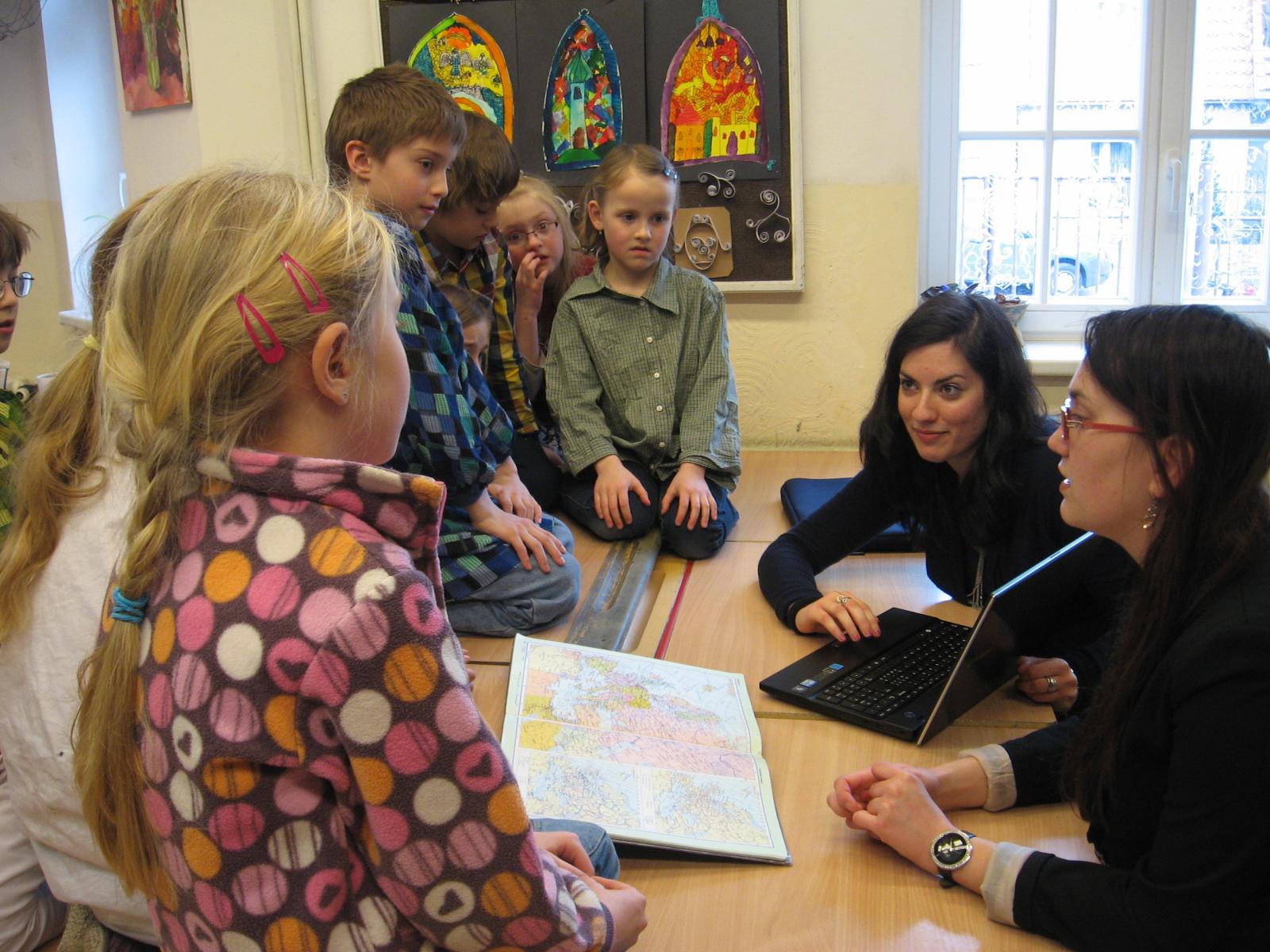There are only a few other festivals around the world that are as popular and well-known as the Carnival of Venice – and only a few places can claim to be as worth seeing and as romantic as this particular historical city. But is this really the reality of living in Venice? We have spoken to Elena Battaglia, a History of Art Erasmus student from the Ca' Foscari University in Venice, who is currently studying at the Catholic Theological Faculty of Charles University, to find out more and also to learn about her art education project “Carnival of Venice”, which Elena has prepared under the guidance of the Europe Meets School programme.
Elena, Let’s start with the Carnival. How did it begin and how is it celebrated today? What is it like to participate in an event like this?
 The Carnival originates from the old pagan Roman tradition of Saturnalia, by way of the medieval Fool's Day, in which social conventions and class divisions were forgotten and poor people were allowed, once a year, to wear masks and to mock their masters.
The Carnival originates from the old pagan Roman tradition of Saturnalia, by way of the medieval Fool's Day, in which social conventions and class divisions were forgotten and poor people were allowed, once a year, to wear masks and to mock their masters.
According to historical documents, the first Carnival-like event in Venice dates back to 1094, and despite the almost disappearance of the tradition between the end of the 18th
Venice in itself is a “freak of nature” among other cities: from the fascinating legend of its foundation, to being built on a platform of hundreds of thousands of wood piles, the history of the rich merchants and the mighty maritime empire, Casanova and Goldoni, la Biennale and the Carnival. It's a miracle within a dream, within a postcard…
Just another example to give you the idea: in the past, the doge (= the governor of Venice or officially the “Serenissima State”) used to establish the peaceful agreement between the city and the sea (of basic importance in a city of merchants, as Venice was) in a very peculiar “marriage” ceremony in the middle of the lagoon, throwing a golden ring into the water to seal their mutual respect and cooperation. Isn't this theatrical enough?
“Carnival of Venice” was also the title of your Europe Meets School project which you held in Olešská Basic Art school. The children in your youngest class (Elena taught altogether 3 different classes) were introduced to the most popular figures of Commedia dell’arte: Harlequin (Arlecchino) and Colombina. Are these typical masks for the Carnival? Who dresses up – is it just the children, or the adults as well?
I tried to recreate the atmosphere of the Carnival with the children in my classes. To start with, I showed them some photos of the city (bridges, water canals, boats and islands), then I focused on San Marco's Square, the main square where all the masked people gather together – this includes adults, in fact the majority of these people are adults! – and most of the celebrations for the Carnival take place.
A very special part of the Carnival is “The flight of the Angel”: a girl dressed like a dove is attached to a wire, which is suspended across the square and she descends on the crowd throwing sweets and chocolates. This marks the beginning of the Carnival.
The main task that the children in my class undertook was to work on Harlequin's traditional dress. Despite the name, it isn’t related to the delicious Czech chocolate cake of the same name (Harlekýn), but to one of Italy’s most traditional masques.
To adults, Harlequin is the comic handyman, Carlo Goldoni's “servant of two masters”, but for children, it is more interesting to look at him as a poor schoolboy whose family was not rich enough to afford to buy him a brand new dress for the ball. All of his friends gave him a piece of fabric which was left over from making their clothes, so that Harlequin's mother would be able to sew a suit for him. This turned out to be the most beautiful dress ever seen, even though it was too small to be of the right size. It was then suggested to him that he should go on a diet for a couple of days to solve this situation! And of course this story was turned into a nice children's song. But I actually have my own explanation for his clothes not fitting - he simply ate too much frittelle, the fried carnival cake!
The older class you taught had a different assignment – they were to create a paper mosaic with a typical view of Venice, e.g. one of the islands with the buildings on it or the port with the bell tower in the background. There have been many artists who specialised in painting Venice – which one did you show them and why?
The aim of the oldest class’s assignment was to focus on the morphological peculiarity of Venice, starting from the most simple but basic visual approach to the city: sea, horizon and sky. I thought this would be interesting because there is nothing comparable to this in Prague. This is why I made the pupils examine and compare three painters, belonging to three extremely different periods, to understand how the same city (and the same views!) can be perceived differently throughout the centuries.
I introduced the class to the extremely realistic and photographic-like depiction of Canaletto's vedute (landscape views), the romantic and blurring watercolours by J. M. W. (Joseph Mallord William) Turner, with the vibrant effect of the sunset on the mirroring sea, and finally I spoke about Virgilio Guidi, an almost unknown Venetian painter of the 1950s who brought the idea of sea, horizon and sky to an extreme but meaningful simplification, capturing the very essence of the lagoon.
Studying in Venice is certainly a dream for most students of Art History. Was Venice also your first choice? What is it like to study this subject there? Are there many benefits – do you, for example, have any seminars held at the historical monuments or in galleries?
 When I first enrolled at university here. my first thought was “I want to see and experience Venice before it sinks!” But humour aside, I think studying and living in Venice is the most unique experience a student can have, more than in other Italian cities like Rome or Florence, especially for a History or History of Art student like me. Here nothing has really changed for centuries; when you walk through the city, what you see is exactly the way it was in the past. It's not just that you can feel the history, you directly step into it!
When I first enrolled at university here. my first thought was “I want to see and experience Venice before it sinks!” But humour aside, I think studying and living in Venice is the most unique experience a student can have, more than in other Italian cities like Rome or Florence, especially for a History or History of Art student like me. Here nothing has really changed for centuries; when you walk through the city, what you see is exactly the way it was in the past. It's not just that you can feel the history, you directly step into it!
The concentration of museums, exhibitions, international fairs and events is perhaps comparable only to Paris. For a student of Art or History of Art, it’s like Heaven! So yes, even if maybe we don't have properly scheduled class trips to museums or galleries (usually the high number of students in a class is difficult to manage during such visits and it also reduces class hours) you can easily do it by yourself. Exploring them is a great asset to your studies.
Venice is a very popular city for tourists and students. However, apart from the main tourist attractions, we do not really know a lot about the city and what life is like for the people who live there. Is it very different to living in other cities? Is it uncomfortable to face the masses of tourists there? Are there some places where you would not necessarily meet the local people?
Venice is not a normal city; it doesn’t have a historical centre surrounded by a metropolitan area. In this way you could say it’s somewhat like an island. This might sound obvious, while it's not. I affectionately call it ‘Veniceland’, as I think it’s like a big funfair, comparable to Disneyland. There are no cars, no new buildings, as there isn’t any space for them and everything has been the same for centuries. You only meet students and tourists here.
A couple of years ago, we celebrated the “Burial of the City”, because the number of citizens actually living on the island (= in Venice) decreased to lower than 60,000. They set up an empty coffin on a boat and sailed along Canal Grande, the main S-shaped canal that crosses the whole city. An alarming signal of the population decrease, and at the same time an act of pride of its citizens and obviously the way of demonstrating it is totally coherent with the spectacular spirit of the Carnival, if you think about it!
The enormous amount of tourists is particularly annoying during spring and summer time, when the invasion is so massive that even walking to school becomes a tortuous slalom between rucksacks and cameras. Luckily, the university area is outside the main route that goes from the train station to San Marco's Square. There are still some pieces of peaceful and genuine Venice, where the only language you hear is their off-key dialect, the small streets are populated by children playing football and, if you take a look up to the sky, you can see fully coloured garlands made of hanging drying clothes. And the sound of one of the hundreds bell towers, of course! But I can't tell you where these hidden places are, or I'll ruin the magic!
Thank you for the interview.















